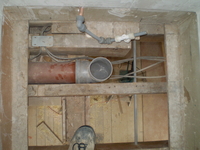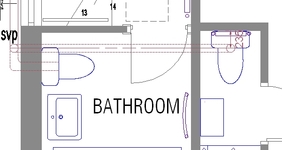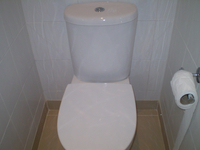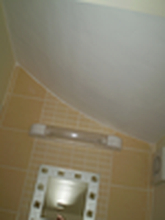CONCEPT: To avoid using an exposed S`trap situation where the drain was in the floor. You would think this should be simple enough but there were barriers to overcome.
Som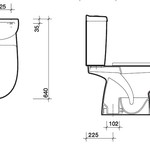 etimes a lot of research and effort has to go into what might seem the simplest of design problems to ensure a functional outcome that will be free of problems in the future.
etimes a lot of research and effort has to go into what might seem the simplest of design problems to ensure a functional outcome that will be free of problems in the future.
OBSTACLE 1]: At the time I was designing this en-suite bathroom, Twyfords discouraged the use of bottom outlet pans in the UK stating in their catalogue that the bottom outlet pan connector was only for export use. Unfortunately they did not qualify those recommendations in their catalogue. Having had experience of Eastern and American bathroom design, I did some homework into this and my first stop was to meet with Building Control to ask if they had any issues with a bottom outlet pan . Our local BC confirmed that they had no issues with the bottom outlet WC Pan.
OBSTACLE2] The other possible problem with bottom outlet WC was siphonage, but since there are no other connections in to the waste pipe eg from a whb and the distance to the svp stack was only about 3 metres, I reckoned that siphonage would not be strong enough to cause a problem
OBSTACLE3] One of the reasons given by Twyfords for why they do not recommend the Bottom outlet connector was that leakages could go unnoticed in a building.The WC in my design is directly above a ceiling and any leakage would certainly not go unnoticed.
ADVANTAGES :Using the bottom outlet pan has a number of advantages over using a P Trap or S Trap in the situation where the waste goes below the floor.
ADVANTAGE 1]The bottom outlet pan is much neater looking since there are no waste pipes showing compared with a stub stack situation which also takes up additional space in the WC and looks ugly unless it is boxed in.
ADVANTAGE 2] It is easier to fix a bottom outlet pan to the floor and create a neat watertight seal than it is to make a PVC waste pipe seal with its floor junction. In the case of a conventional HO(horizontal outlet ) pan and depending on the space available, the cistern can end up being 40mm to 70mm away from the wall . So in this context, the bottom outlet (BO) pan saves space.
Conditions of using the bottom outlet:In order to make a successful installation the following need to be observed however:
MEASURING : You need to get the positioning accurate at a stage when building work is in the early stages and you need to know your wall thickness sums therefore.
Remember to add 10 to 20mm for a ventilation gap between the cistern and the wall. (otherwise trapped condensation will lead to mould growth).
FALL: You also need to make sure you have enough space below floor level for the
bend and an adequate fall on the pipe. (My floor joists were 170mm deep and I had a dropped ceiling at one point to accommodate the fall,see illustration below)
SIPHONAGE: Be aware of siphonage and if there is sufficient space between the joists it might be worth continuing the 110mm waste and terminating somewhere, perhaps outside the WC, with a stub and AutoAirVent. As a precaution I did not connect any other pipes eg whb in to the waste. Rodding access: I put an inspection junction/branch where the waste from below the floor joined the vertical stack outside.
SUPPORT FOR PIPEWORK] Bend below the WC: Make sure that the pipe below the WC is well supported so that there is no stress on the pan connector which could make the pan connector come loose.
CONCLUSION : This WC has been in use for over 2 years now and I would have no
hesitation in repeating the design solution here.The Twyfords bottom outlet therefore provides a neat solution and without pipes emerging from the toilet pan there is no grime to collect.
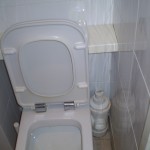
By Comparison with the Bottom outlet arrangement, the stub-stack is located in the corner providing a difficult situation to seal around.

